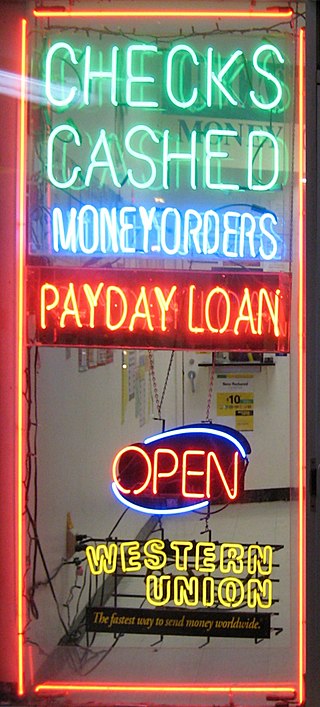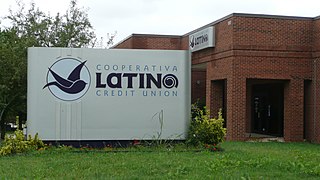Related Research Articles

Redlining is a discriminatory practice in which services are withheld from potential customers who reside in neighborhoods classified as "hazardous" to investment; these neighborhoods have significant numbers of racial and ethnic minorities, and low-income residents. While the best-known examples involve denial of credit and insurance, also sometimes attributed to redlining in many instances are denial of healthcare and the development of food deserts in minority neighborhoods. In the case of retail businesses like supermarkets, the purposeful construction of stores impractically far away from targeted residents results in a redlining effect.

Microfinance is a category of financial services targeting individuals and small businesses who lack access to conventional banking and related services. Microfinance includes microcredit, the provision of small loans to poor clients; savings and checking accounts; microinsurance; and payment systems, among other services. Microfinance services are designed to reach excluded customers, usually poorer population segments, possibly socially marginalized, or geographically more isolated, and to help them become self-sufficient. ID Ghana is an example of a microfinance institution.

A transaction account, also called a checking account, chequing account, current account, demand deposit account, or share draft account at credit unions, is a deposit account or bank account held at a bank or other financial institution. It is available to the account owner "on demand" and is available for frequent and immediate access by the account owner or to others as the account owner may direct. Access may be in a variety of ways, such as cash withdrawals, use of debit cards, cheques and electronic transfer. In economic terms, the funds held in a transaction account are regarded as liquid funds. In accounting terms, they are considered as cash.

A payday loan is a short-term unsecured loan, often characterized by high interest rates.

The Community Reinvestment Act is a United States federal law designed to encourage commercial banks and savings associations to help meet the needs of borrowers in all segments of their communities, including low- and moderate-income neighborhoods. Congress passed the Act in 1977 to reduce discriminatory credit practices against low-income neighborhoods, a practice known as redlining.

Capital One Financial Corporation is an American bank holding company specializing in credit cards, auto loans, banking, and savings accounts, headquartered in McLean, Virginia with operations primarily in the United States. It is on the list of largest banks in the United States, is the third largest issuer of Visa and Mastercard credit cards and is one of the largest car finance companies in the United States.

Cooperative banking is retail and commercial banking organized on a cooperative basis. Cooperative banking institutions take deposits and lend money in most parts of the world.
The underbanked is a characteristic describing people or organizations who do not have sufficient access to mainstream financial services and products typically offered by retail banks and thus often deprived of banking services such as credit cards or loans. The underbanked can be characterized by a strong reliance on non-traditional forms of finance and micro-finance often associated with disadvantaged and the poor, such as cheque cashers, loan sharks and pawnbrokers.
Financial inclusion is the availability and equality of opportunities to access financial services. It refers to a process by which individuals and businesses can access appropriate, affordable, and timely financial products and services which include banking, loan, equity, and insurance products.It is a path to enhance inclusiveness in economic growth by enabling the unbanked population to access the means for savings, investment, and insurance towards improving household income and reducing income inequality

A banking agent is a retail or postal outlet contracted by a financial institution or a mobile network operator to process clients’ transactions. Rather than a branch teller, it is the owner or an employee of the retail outlet who conducts the transaction and lets clients deposit, withdraw, transfer funds, pay their bills, inquire about an account balance, or receive government benefits or a direct deposit from their employer. Banking agents can be pharmacies, supermarkets, convenience stores, lottery outlets, post offices, and more.
Bank regulation in the United States is highly fragmented compared with other G10 countries, where most countries have only one bank regulator. In the U.S., banking is regulated at both the federal and state level. Depending on the type of charter a banking organization has and on its organizational structure, it may be subject to numerous federal and state banking regulations. Apart from the bank regulatory agencies the U.S. maintains separate securities, commodities, and insurance regulatory agencies at the federal and state level, unlike Japan and the United Kingdom. Bank examiners are generally employed to supervise banks and to ensure compliance with regulations.

A bank is a financial institution that accepts deposits from the public and creates a demand deposit while simultaneously making loans. Lending activities can be directly performed by the bank or indirectly through capital markets.
The New York State Banking Department was created by the New York Legislature on April 15, 1851, with a chief officer to be known as the Superintendent. The New York State Banking Department was the oldest bank regulatory agency in the United States.
The unbanked are adults who do not have their own bank accounts. Along with the underbanked, they may rely on alternative financial services for their financial needs, where these are available.

An alternative financial service (AFS) is a financial service provided outside traditional banking institutions, on which many low-income individuals depend. In developing countries, these services often take the form of microfinance. In developed countries, the services may be similar to those provided by banks and include payday loans, rent-to-own agreements, pawnshops, refund anticipation loans, some subprime mortgage loans and car title loans, and non-bank check cashing, money orders, and money transfers. It also includes traditional moneylending by door-to-door collection. In New York City, these are called check-cashing stores, and they are legally exempted from the 25 percent criminal usury cap.

A cost of poverty, also known as a ghetto tax, a poverty premium, a cost of being poor, or the poor pay more, is the phenomenon of people with lower incomes, particularly those living in low-income areas, incurring higher expenses, paying more not only in terms of money, but also in time, health, and opportunity costs. "Costs of poverty" can also refer to the costs to the broader society in which poverty exists.

A payday loan is a small, short-term unsecured loan, "regardless of whether repayment of loans is linked to a borrower's payday." The loans are also sometimes referred to as "cash advances," though that term can also refer to cash provided against a prearranged line of credit such as a credit card. Payday advance loans rely on the consumer having previous payroll and employment records. Legislation regarding payday loans varies widely between different countries and, within the United States, between different states.

A public bank is a bank, a financial institution, in which a state, municipality, or public actors are the owners. It is an enterprise under government control. Prominent among current public banking models are the Bank of North Dakota, the Sparkassen-Finanzgruppe in Germany, and many nations’ postal bank systems.

Payments banks are a new model of banks, conceptualised by the Reserve Bank of India (RBI), which cannot issue credit. These banks can accept a restricted deposit, which is currently limited to ₹200,000 per customer and may be increased further. These banks cannot issue loans and credit cards. Both current account and savings accounts can be operated by such banks. Payments banks can issue ATM cards or debit cards and provide online or mobile banking. Bharti Airtel set up India's first payments bank, Airtel Payments Bank.

The Latino Community Credit Union (LCCU) is located in Durham, North Carolina. The LCCU was established in 2000 in Downtown Durham, North Carolina. It became the first Latino credit union in North Carolina and is currently the only Latino Credit Union in the state. Today, it has over 90,000 members and 15 locations across North Carolina.
References
- 1 2 3 Cookson, Tony (February 20, 2020). "Column: How growing up in a bank desert can hurt your credit for the rest of your life". PBS NewsHour . Retrieved March 30, 2020.
- ↑ "'Banking Deserts' Spread Across Low-Income Neighborhoods". NPR. 13 November 2013. Retrieved 16 May 2015.
- ↑ Watson, Andrea V. (27 October 2014). "Banking Desert Communities, More Blacks Live in Them". Chicago Defender.
- ↑ Einaudi 2008, p. 142.
- ↑ "Postal Banking to the Rescue in both Canada and the U.S." Canadian Union of Postal Workers. 4 June 2014. Retrieved 16 May 2015.
- 1 2 Despard, Mathieu (March 13, 2016). "Life in a Banking Desert". The Atlantic . Retrieved March 30, 2020.
- ↑ Ross, Janell (June 15, 2019). "How Itta Bena, Mississippi, became a banking desert". NBC News . Retrieved April 6, 2020.